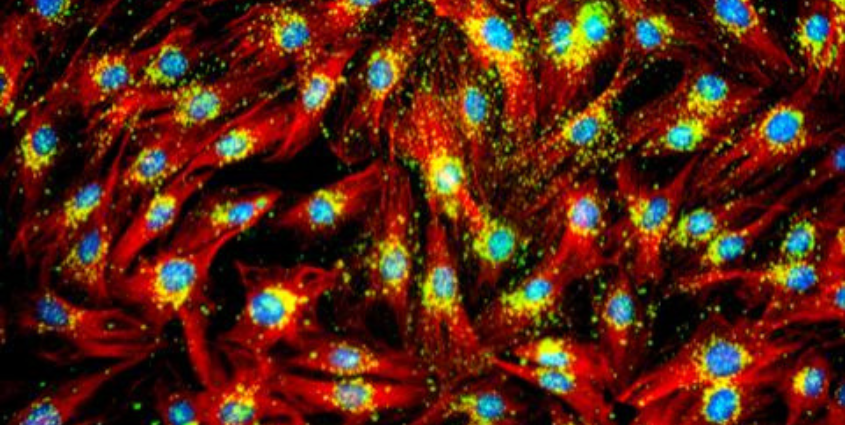OU Health Sciences Center Researcher Discovers Behavior of Toxic Protein That Can Cause Alzheimer’s
- Category: News, Adults Services
- Posted On:

 Simply getting older is the primary risk factor for developing Alzheimer’s disease. There may not be a way to turn back time, but the research community increasingly recognizes that if the process of aging can be slowed, the onset of diseases like Alzheimer’s may be delayed as well. A recent publication by an OU College of Medicine researcher at OU Health Sciences Center builds on that knowledge by illuminating the behavior of a pathogenic protein that accelerates aging in the brain.
Simply getting older is the primary risk factor for developing Alzheimer’s disease. There may not be a way to turn back time, but the research community increasingly recognizes that if the process of aging can be slowed, the onset of diseases like Alzheimer’s may be delayed as well. A recent publication by an OU College of Medicine researcher at OU Health Sciences Center builds on that knowledge by illuminating the behavior of a pathogenic protein that accelerates aging in the brain.
The study comes from the laboratory of Veronica Galvan, Ph.D., professor and Donald W. Reynolds Endowed Chair of Aging Research in the Department of Biochemistry and Molecular Biology, OU College of Medicine. In her study, published April 25 in the journal Nature Communications, she demonstrates just how damaging a protein called tau can be when it becomes pathogenic.
Tau's Role in Alzheimer's Disease
Tau plays an important role in healthy brain cells, but in the process of aging, tau can begin to “misfold” and take on a new formation that is pathogenic. Once it does, tau is transmitted from neuron to neuron until it has infiltrated the long neuronal chain that forms the electric circuit of the brain. In Galvan’s new study, she discovered an additional destructive step for tau — the protein is able to move into the nearby endothelial cells, which play a crucial role in the brain maintaining healthy blood flow.
“That was a surprise to us,” she said. “In the endothelial cell, tau triggers a process called senescence that is central to the biology of aging.”
When endothelial cells become senescent, they can’t do their jobs well anymore. They become highly inflammatory and damage surrounding cells, causing accelerated aging in the blood vessels of the brain. Senescence is also a precursor to atherosclerosis, which is a buildup of plaque in the arteries that obstructs blood flow.
“Even before you see any cognitive impairments, you have dramatic changes in blood flow in the brain. The brain is extraordinarily dependent on blood flow to get oxygen and glucose,” Galvan said. “Pathogenic tau is a cause of Alzheimer’s disease. That is important to understand because if we can remove pathogenic tau from the brain or block tau-induced endothelial cell senescence, then we may be able to prevent damage or restore brain function.”
In the same study, Galvan’s team tested whether a particular antibody could remove toxic tau from the brains of mice. The antibody, which was provided by a collaborating researcher, was able to restore about half of the mice’s brain function. The antibody is being prepared for clinical trials and will be further studied for its role in removing toxic tau.
“We were not able to completely restore function, but we were able to reduce the deficit by about half,” she said. “That was with only one course of treatment, so it could be improved.”
Clinical Trials for Improvement
Galvan’s next step is to look for ways to block tau from entering endothelial cells. Her lab plans to perform genome-wide genetic screens at the Center for Therapeutic Sciences at the OU Health Sciences Center to determine which genes allow pathogenic tau to enter the cells.
“Once we know which genes are involved, we can act from the other side — instead of trying to remove all of the tau, we can protect the cells by preventing the entry of tau,” she said. “Maybe there are drugs already available that can block tau, or perhaps we could develop a new drug at the Center for Therapeutic Sciences.”
Before arriving at the OU Health Sciences Center, Galvan worked at the University of Texas Health Science Center at San Antonio, where she played a pivotal role in advancing the drug rapamycin to clinical trials for the treatment of Alzheimer’s disease. The discovery of a drug like rapamycin that targets the rate of aging opened the door for researchers to deepen their studies into the biology of aging and its role in age-associated disease. The field of research is known as geroscience, a growing area of interest and federal funding.
“By targeting the rate of aging, we can, in principle, reduce the risk for a large variety of diseases,” Galvan said. “The idea is that we could help people maintain their health span, their healthy years of life. It would allow for what we call a compression of morbidity — people will still eventually develop health problems, but it would happen in a compressed amount of time and allow for a much longer span of health.”
Galvan is also director of the Oklahoma Nathan Shock Center of Excellence in the Basic Biology of Aging and co-director of the Center for Geroscience and Healthy Brain Aging at the OU Health Sciences Center. The first author for the new publication is Stacy Hussong, Ph.D., assistant professor of research in the Department of Biochemistry and Molecular Biology at the OU College of Medicine. Also serving as first author is Andy Banh, Ph.D., a medical student at the University of Texas Health San Antonio Long School of Medicine.

.png)
